Images
Photographed 1985-1988 except as noted.Select an image to view a larger version
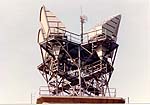
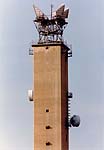
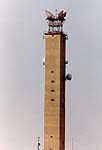
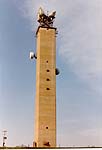
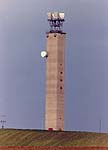

June, 1994
This site was a repeater on the first transcontinental microwave route.
The tower was constructed in early 1950 using the continuous pour, slip form method, it is a type 4D square concrete tower, 190' 6" tall, and initially had 2 delay lens antennas on the roof. One antenna received radio traffic from the next repeater station Eastward at Princeton, IA, the other antenna sent radio traffic Westward to the next station at Morse, IA. This section of the route was initially fitted with two TD-2 radio channels to carry network television programming from East to West.
Two more delay lens antennas were installed in early 1951 to carry traffic going Eastbound. Four more TD-2 radio bays were also installed to provide two new Eastbound channels, and two additional Westbound channels, all four channels were intended for message service.
Additional TD-2 radio bays were installed over the next four years, so that by 1955 six channels in each direction were in place, the maximum possible with the delay lens antennas. Each direction had 4 TV channels, 1 message channel, and a protection channel.
In 1962 a major upgrade of this route was initiated to provide for the addition of 5 TD-2 interstitial channels westbound and 6 channels eastbound for greater message capacity. First, in order to keep the repeater site on-line during construction, temporary 8 foot diameter parabolic antennas were installed on the sides of the tower, just below the roof. Next, after the microwave radio equipment was cut over to the temporary parabolics, the delay lens antennas were removed, and a 25 foot tall steel platform holding 4 horn antennas was constructed on the roof. After the horns were aligned to the microwave path, the microwave radios were transferred from the parabolics to the horns. An additional radio channel was added sometime later, making a total of 12 channels in each direction.
AR6A single sideband microwave radios operating at 6 GHz were added in 1981 for a further increase in message capacity. Two shielded parabolic antennas providing space diversity receive capability were installed part way up the concrete section of the tower. The site was taken out of service around 1992.
In December 1993 AT&T sold the tower and the property to Cedar Rapids Cellular Telephone Limited Partnership. The new owner dismantled and removed the 4 horn antennas and the 25' tall platform on the roof. They then installed a new four sided tapered tower on the roof, approximately 80 feet tall, supporting two microwave antennas. Two more microwave antennas were installed on the side of the building.
 |
 |
 |
 |
 |
 June, 1994 |
Created on February 13, 2002 at 19:10 by Albert LaFrance